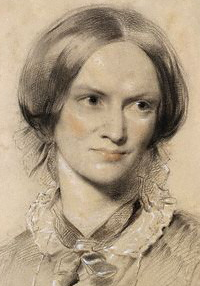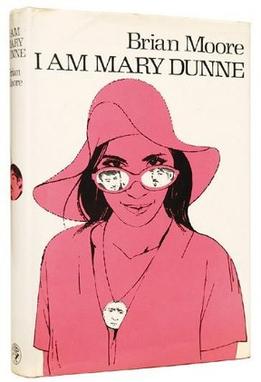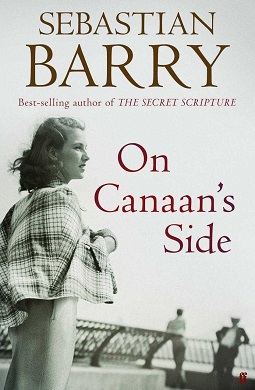
Charlotte Nicholls, commonly known as Charlotte Brontë, was an English novelist and poet, the eldest of the three Brontë sisters who survived into adulthood and whose novels became classics of English literature. She is best known for her novel Jane Eyre, which she published under the male pseudonym Currer Bell. Jane Eyre went on to become a success in publication, and is widely held in high regard in the gothic fiction genre of literature.

Waiting for Godot is a play by Irish playwright Samuel Beckett in which two characters, Vladimir (Didi) and Estragon (Gogo), engage in a variety of discussions and encounters while awaiting the titular Godot, who never arrives. Waiting for Godot is Beckett's reworking of his own original French-language play, En attendant Godot, and is subtitled "a tragicomedy in two acts". In a poll conducted by the British Royal National Theatre in 1998/99, it was voted as, "the most significant English-language play of the 20th century".

Elizabeth Cleghorn Gaskell, often referred to as Mrs Gaskell, was an English novelist, biographer, and short story writer. Her novels offer a detailed portrait of the lives of many strata of Victorian society, including the very poor. Her first novel, Mary Barton, was published in 1848. Gaskell's The Life of Charlotte Brontë, published in 1857, was the first biography of Charlotte Brontë. In this biography, she wrote only of the moral, sophisticated things in Brontë's life; the rest she omitted, deciding certain, more salacious aspects were better kept hidden. Among Gaskell's best known novels are Cranford (1851–1853), North and South (1854–1855), and Wives and Daughters (1864–1866), all of which were adapted for television by the BBC.

Maurice Gough Gee is a New Zealand novelist. He is one of New Zealand's most distinguished and prolific authors, having written over thirty novels for adults and children, and has won numerous awards both in New Zealand and overseas, including multiple top prizes at the New Zealand Book Awards, the James Tait Black Memorial Prize in the UK, the Katherine Mansfield Menton Fellowship, the Robert Burns Fellowship and a Prime Minister's Award for Literary Achievement. In 2003 he was recognised as one of New Zealand's greatest living artists across all disciplines by the Arts Foundation of New Zealand, which presented him with an Icon Award.
This article contains information about the literary events and publications of 1847.

I Am Mary Dunne is a novel, first published in 1968, by Northern Irish-Canadian writer Brian Moore about one day in the life of a beautiful and well-to-do 31-year-old Canadian woman living in New York City with her third husband, a successful playwright. Triggered by seemingly unimportant occurrences, the protagonist / first person narrator remembers her past in a series of flashbacks, which reveal her insecurities, her bad conscience concerning her first two husbands, and her fear that she is on the brink of insanity.

Emily "Mickey" Hahn was an American journalist and writer. Considered an early feminist and called "a forgotten American literary treasure" by The New Yorker magazine, she was the author of over 50 books and more than 200 articles and short stories.

William John Banville is an Irish novelist, short story writer, adapter of dramas and screenwriter. Though he has been described as "the heir to Proust, via Nabokov", Banville himself maintains that W. B. Yeats and Henry James are the two real influences on his work.
Events from the year 1952 in Ireland.

Eamonn Casey was an Irish Catholic priest who served as bishop of Galway and Kilmacduagh in Ireland from 1976 to 1992. His resignation in 1992, after it was revealed he had had an affair with an American woman, Annie Murphy, was a significant event in the history of the Irish Catholic Church.
Desmond Hogan is an Irish writer. Awarded the 1977 Rooney Prize for Irish Literature and 1980 John Llewellyn Rhys Prize, his oeuvre comprises novels, plays, short stories and travel writing.
Sebastian Barry is an Irish novelist, playwright and poet. He was named Laureate for Irish Fiction, 2018–2021.

The Steward of Christendom is a 1995 play written by Irish playwright Sebastian Barry. It focuses on Thomas Dunne, loosely based on Barry's great-grandfather, the former chief superintendent of the Dublin Metropolitan Police, now (1932) confined to a psychiatric facility. The play recounts Dunne's personal and public life throughout the 1910s and into the early 1920s.
Vikram Chandra is an Indian-American writer. His first novel, Red Earth and Pouring Rain, won the 1996 Commonwealth Writers' Prize for Best First Book.
Mary Morrissy is an Irish novelist and short story writer. She writes on art, fiction, and history. Morrissy is an elected member of Aosdána, Ireland's academy of artists and writers.
Matthew Gerard Sweeney was an Irish poet. His work has been translated into Dutch, Italian, Hebrew, Japanese, Latvian, Mexican Spanish, Romanian, Slovakian and German.
Robert Ian Duhig is a British-Irish poet. In 2014, he was chair of the judging panel for the T. S. Eliot Prize awards.
"Weela Weela Walya", also called "Weila Waile", "Wella Wallia" or "The River Saile", is an Irish schoolyard song that tells the story of an infanticide in a light-hearted way. It was popularised in the 1960s by Irish folk bands the Dubliners and the Clancy Brothers.

On Canaan's Side is a 2011 novel written by Irish playwright and novelist Sebastian Barry.

Sally Rooney is an Irish author and screenwriter. She has published four novels: Conversations with Friends (2017), Normal People (2018), Beautiful World, Where Are You (2021), and Intermezzo (2024). The first two were adapted into the television miniseries Normal People (2020) and Conversations with Friends (2022).











